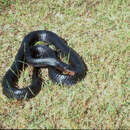More info for the terms:
cover,
herbaceousEastern indigo snakes are a commensal species associated with gopher tortoises.
Snakes use abandoned tortoise burrows heavily in the winter and spring
[
1]. For this reason it is necessary to maintain healthy tortoise
populations, also a species in decline throughout its range. Because
slash piles are used by snakes for hiding and foraging, this debris
should be left intact on pine plantations [
6]. Speake and others [
9]
recommend protecting several thousand hectares of prime eastern indigo snake
habitat to ensure the snakes' year-round needs are met. Some important
sandhill communities of Georgia and Florida are being replaced by slash
pine plantations, which can support a few snakes if burned and planted
with wide spacing to encourage gopher tortoise populations [
6].
Recommendations for captive breeding of eastern indigo snakes are as follows
[
10]: Captive snakes should be released to the wild after 2 to 3 years,
and new snakes from the wild should be introduced to the captive
population, preferably every winter. This is important because wild
snakes seem to grow faster and produce more young than snakes held in
captivity. Because smaller snakes do not use tortoise burrows, they
should be released in wetland areas with plenty of herbaceous cover near
the water's edge. Hatchlings will den in areas with dense saw palmetto
(Serenoa repens) and should be released near these areas.

